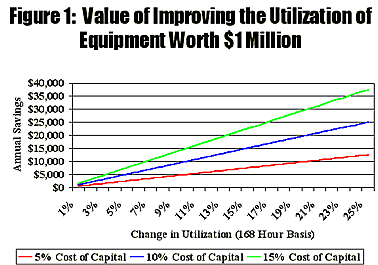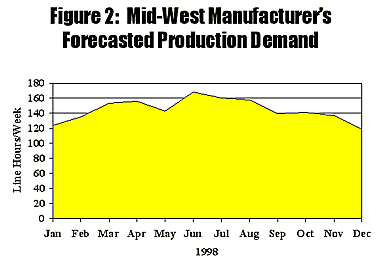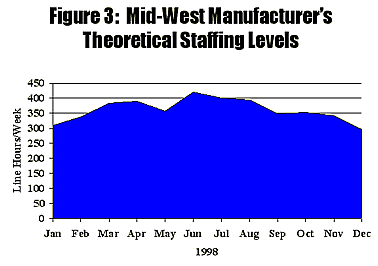When considering alternative shift schedules, you should evaluate how they affect your cost structure and whether they make your operation easier to manage. At a minimum, an effective schedule should:
- Keep your best and/or most expensive equipment productive, i.e. maximize your equipment utilization.
- Provide continuous coverage in areas that have significant start-up and shutdown costs.
- Match the coverage to the workload. In other words, provide enough coverage to get the necessary work done, and no more.
- Have the ability to flex up to meet customer demands, flex down when workload is low.
- Not be constrained by pay and work policies that make normal operating situations excessively expensive.
Let’s examine each of these five characteristics in more detail.
Maximize Equipment Utilization
Equipment utilization can be a huge economic driver in establishing the level of coverage that your schedule should provide. Since there are 168 available operating hours in a week (24 x 7), you should use this as your basis for evaluating equipment utilization.
Part of the operating hours is used for maintenance, setup, cleaning and product changeovers. The typical plant loses 15% of its operating time to perform these functions, which reduces equipment utilization to 85%.
Many companies plan their operations around a schedule that provides five days of coverage, 24 hours a day. This is a 120-hour planning week that, at best, yields an equipment utilization of 71.4% (120/168). Using the typical 0.85 operating factor results in a utilization of only 60.7%.
Therefore, the typical facility running five days a week can expect to increase equipment utilization by about 24% (85% – 60.7%) with a 7-day schedule.

Figure 1 demonstrates the value of improving the equipment utilization for $1 million worth of equipment. As an example, if your plant has $25 million of capital and equipment invested at a 10% cost of capital, you could realize a savings of $550,000/year by changing from 5-days to 7-days a week.
Provide Continuous Coverage
In a manufacturing environment, there are often significant benefits to using a schedule that provides continuous coverage. Operations that unnecessarily shut down their equipment for breaks, lunches, shift changes, or at the conclusion of the workweek are probably increasing their overall cost structure. Increased costs are generated by:
- Losses of equipment utilization of up to 11%.
- Labor required to complete start-up and shutdown procedures (cleaning, setup, and adjustment) that does not result in actual production and would not be required if the equipment continued to operate.
- Scrap created as part of the start-up or shutdown process.
- Lost capacity opportunity experienced as the “bugs” are worked out of the system on start-up. This also results in lower labor productivity.
- Increased maintenance problems caused by cycling the equipment more than necessary.
Continuous coverage can be provided at shift change by having face-to-face turnover meetings between operators on attended equipment. While this may require some overlap, it also creates an environment of accountability and fosters communication between shifts.
Equipment does not need to be shut down for breaks and lunches if a break relief system is used. One of the best systems uses dedicated relief personnel who move from position to position to allow operating personnel to take breaks. In addition to keeping equipment running, this type of system encourages personnel to stick to their assigned break times so that they do not adversely affect their co-workers.
In some plants, an alternative to using relief personnel is to run short-staffed during breaks and use cross-trained personnel from nearby areas to alert personnel on break if a problem occurs. This usually is not as effective as using actual relief personnel, since problems that do occur during a break are normally not handled as well as they would be if dedicated personnel were readily available.
Match Coverage to the Workload
It is surprising how many companies force their production and staffing plans to fit their shift schedule rather than the other way around. This type of mismatch can result in hidden costs that could easily be eliminated with an appropriate schedule.
As an example of this type of situation, consider a manufacturer with ten production lines using a traditional 120-hour (5×24) schedule. This plant’s product demand requires the ten lines to run about 90% of the time. In other words, one line will normally be scheduled down at any given time, resulting in 10% overstaffing in the plant.
An alternative to this strategy is to design a schedule that would provide 90% of the current coverage, i.e. a schedule that provides full coverage for 108 hours each week. This will eliminate the 10% idle time built into the traditional 120-hour schedule, and lower facility costs such as utilities.
Let’s assume the managers at this plant have done their homework, and recognize the overstaffing situation. They realize that their employees are going to be absent for about two and a half weeks for vacations and about one week for illness and other reasons (this is about 7% absenteeism). Given this situation, they have made the decision to staff for ten lines, and reassign personnel from the down line to fill coverage gaps on the operating lines.
This all sounds reasonable, but it isn’t cheap. Even if the absence theory holds up, the plant still appears to be three percent overstaffed. In reality, the absence theory does not hold up either. Seven percent of the workforce will not be absent every day the plant operates. Some days it will be more than seven percent and other days it will be less. The two possible solutions are to reduce the day-to-day staffing and never run ten lines at a time, or to implement a schedule with less than 120 hours/week of coverage.
Prepare for Variable Workloads
Many manufacturing companies experience variable workloads due to changes in product demand, or variable staffing availability due to vacations and illness. For example, Figure 2 shows the weekly operating hours needed to meet the production demand for one year at a Mid-Western manufacturer.

In order to provide exactly the right amount of coverage for this type of variable workload using personnel working 40-hour workweeks and no overtime, we would continually increase and decrease the staffing in parallel with the changing product demand. For example, assuming 100 people are required to staff this plant with straight time, given the changing product demand, the number of people required would vary as shown in Figure 3.

Since most companies want to keep employees for the long term, they try to maintain the same staffing level throughout the year. This makes a situation like the one shown in Figure 3 undesirable. Therefore, variable demand fluctuations are met by varying the coverage with secondary coverage adjustment mechanisms, such as planned overtime, temporary employees, training and other discretionary work management, and planned time-off management. Short-term adjustments include unplanned overtime and using temporary or contract labor.
Revise Pay and Work Policies
The best shift schedules have a set of pay and work policies that are matched to the schedule. Most pay and work policy systems were designed to manage a Monday through Friday, eight-hour shift schedule. Typical policies on this schedule include:
- Daily premium paid for hours worked beyond 8 hours/day.
- Weekend premiums for working on Sat. and Sun.
- Holidays, vacations, and other paid time-off is paid and tracked in eight-hour blocks.
When these policies are applied to schedules that use different shift lengths or cover more than five days in a week, they will usually increase the cost to operate the facility. This increased cost results in more operating restrictions and lowers your ability to respond to your customers’ demands.
The best schedules have custom designed pay and work policies that allow the operation the maximum flexibility while still meeting the principles that traditional schedules were designed to meet. That is, they:
- Meet all Federal, State, and Local labor laws.
- Pay employees a premium when they must work in unusual situations (e.g. work longer than scheduled or on a day-off).
- Provide income replacement for paid time off.
- Equalize pay when workweeks are not balanced.
- Equally compensate employees working the same jobs, side-by-side, under the same conditions (including number of hours worked and days off), on different shift schedules.
Satisfying these principles should result in a schedule and pay/work policy combination that avoids the 2-15% cost increase that many companies feel they must absorb when they change to a schedule that better meets their production demands.
Satisfy Employee Requirements
While the focus of this article has been on the business characteristics of effective shift schedules, effective schedules also meet the needs of the workforce. The schedule belongs to the people that work it, and at most companies, things run better when the people are happy. Some of the top issues that employees want to see addressed when they are asked to evaluate alternative schedules are:
- Pay — especially overtime and weekend/shift premiums.
- Time off — especially on weekends and holidays.
- Predictability. Most workers prefer some consistency in their time off.
- Job difficulty & fatigue — long shifts, numerous shifts worked in a row, and rate of rotation all can affect the attractiveness of a shift schedule.
The bottom line is that you must understand what your employees want if you are going to implement a successful schedule. The best schedule for the business is no good if the employees can’t live with it.
We can help you find the most effective shift work solution to address your needs. Call or text us today at (415) 763-5005.

